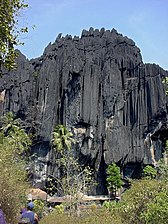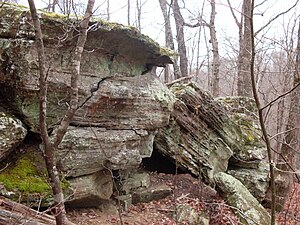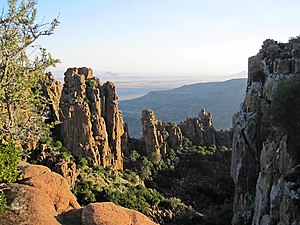Outcrop
This article needs additional citations for verification. (September 2011) |

An outcrop or rocky outcrop is a visible exposure of bedrock or ancient superficial deposits on the surface of the Earth.[1]
Features
Outcrops do not cover the majority of the Earth's land surface because in most places the bedrock or superficial deposits are covered by
Bedrock and superficial deposits may also be exposed at the Earth's surface due to human excavations such as quarrying and building of transport routes.
Study
Outcrops allow direct observation and sampling of the
Accurate description, mapping, and sampling for laboratory analysis of outcrops made possible all of the geologic sciences and the development of fundamental geologic laws such as the law of superposition, the principle of original horizontality, principle of lateral continuity, and the principle of faunal succession.
Examples
On
-
Precambrian outcrop in Finland
-
Silesian Stones Mountain in southwestern Poland
-
Outcrop near Yana, India
-
Outcrop in theVasquez Rocks Natural Area Park of southern California
-
Valley of Desolation in the Camdeboo National Park
See also
References
- ^ Howell, J. V., 1960, Glossary of Geology and Related Sciences. Washington, DC: American Geological Institute, pp. 207-208
- ^ "oxy.edu. Vazquez Rocks. access date:5/22/2010". Archived from the original on 2011-06-08. Retrieved 2010-05-24.
- ^ "parks.lacounty.gov. Vazquez Rocks Natural Area and Nature Center. access date:5/22/2010". Archived from the original on 2012-09-20. Retrieved 2010-05-24.







